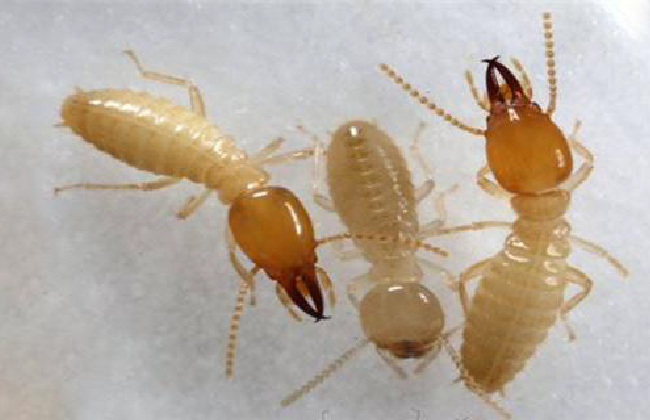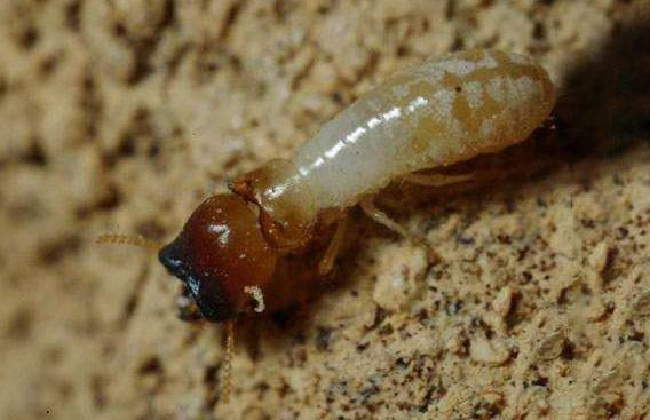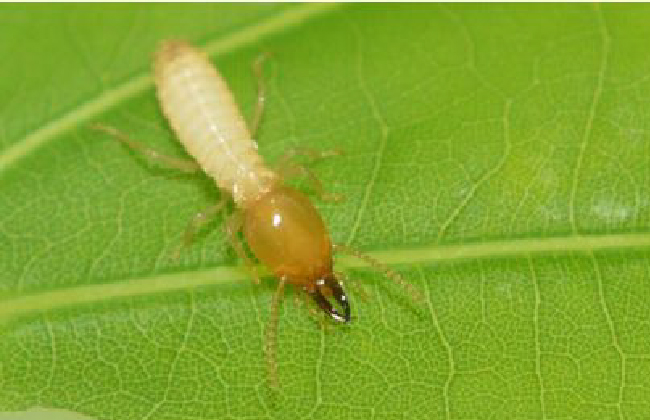 Dry Wood Termites ( Cryptotermes spp.) Dry Wood Termites ( Cryptotermes spp.)
-Larve – 1mm long, translucent white
-Soliders - 5mm pale thorax and abdomen with a darker head
-Adults – bodies up to 7mm, or 11mm including wings
-The winged adults (alates) emerge from the nest and swarm. After a short flight, they land and shed their wings
-0nce the females attract a male they seek a suitable site, e.g. a crack in a dry timber beam, and begin to excavate a chamber.
-They do not mate until they are sealed into their nest. Mating occurs throughout the life of the colony
-The development of the colony is slow and after 1 year, the king and queen may only have produced 3 or 4 larave
-The larvae develop into workers, soldiers or alates
-They infest dry timber, e.g. structural timber
-They expand their nests by eating thorough timber in all directions, eventually leaving just follow, yet otherwise normal appearing piece of timber
-They are most frequently detected by the frass that if rejected from the infected timber
 Subterranean Termites ( Coptotermes spp. Queen) Subterranean Termites ( Coptotermes spp. Queen)
- Length 5-10mm
- White, broad bodies with a brown head
- Queens can lay several thousands of eggs in one day and live up to ten years
- The king remains only slightly bigger than an average termite and continues to mate with the queen for life
- Males in ant colonies die immediately after mating, unlike termite male Alates, which become kings and live with the queen
- Nests are built in the soil and these termites are very dependent on soil for moisture
- In their search for food, subterranean termites construct mud tubes because they are susceptible to desiccation when exposed to air
 Coptoermes formosanus ( Coptotermes formosanus) Coptoermes formosanus ( Coptotermes formosanus)
- Orange-brown and yellow brown
- Length 0.5-0.6 inches
- Wings are covered with fine hairs
- Termites have a caste system where there are workers, soldiers, and reproductive adults called queens and kings
- Workers provide the food, tend the eggs and build the nest
- Soldiers defend the nest
- The king and queen are the primary reproductive. If either of them dies or if the colony becomes too large,winged
reprodcutives ( Alates) are sent out to begin nest colonies
- A single colony can be up to 300 feet and can contain several million termites
- They infest a huge variety of structures including boat, high-rise condominiums and also trees
- Formosan termites consume wood at a rapid rate compared to other species which can cause major structural damage to homes and buildings
- Also know to feed on paper, cardboard and foam insulation boards
- They are seen in huge swarms in the evening when the weather is humid, usually between April – July
|
 Loading... Please wait...
Loading... Please wait... Loading... Please wait...
Loading... Please wait...